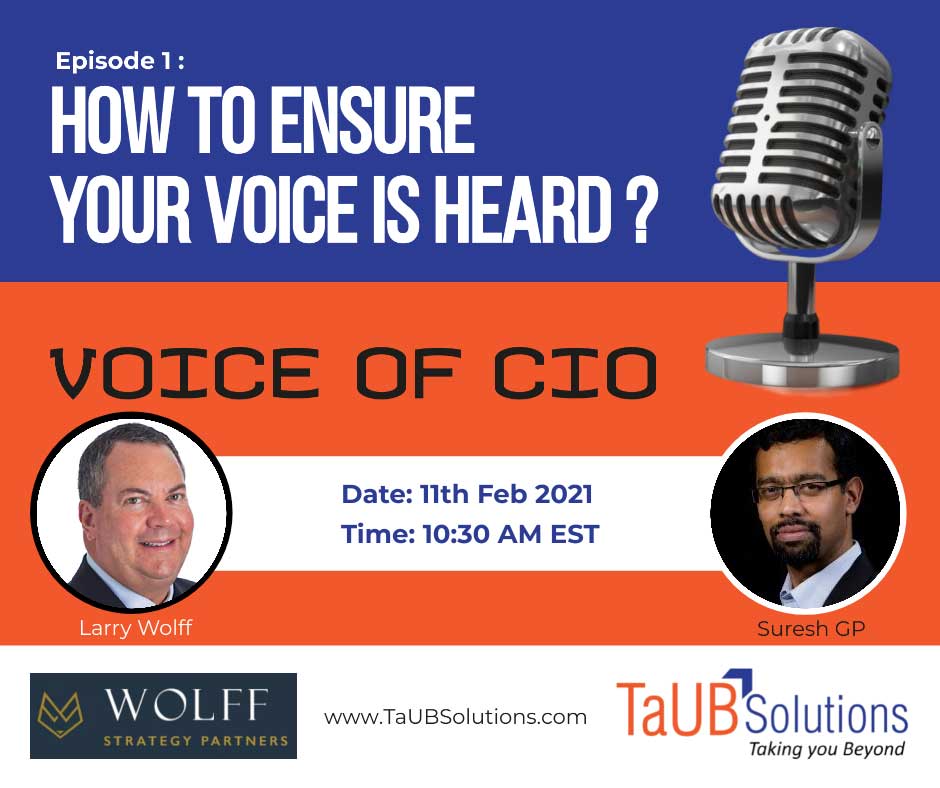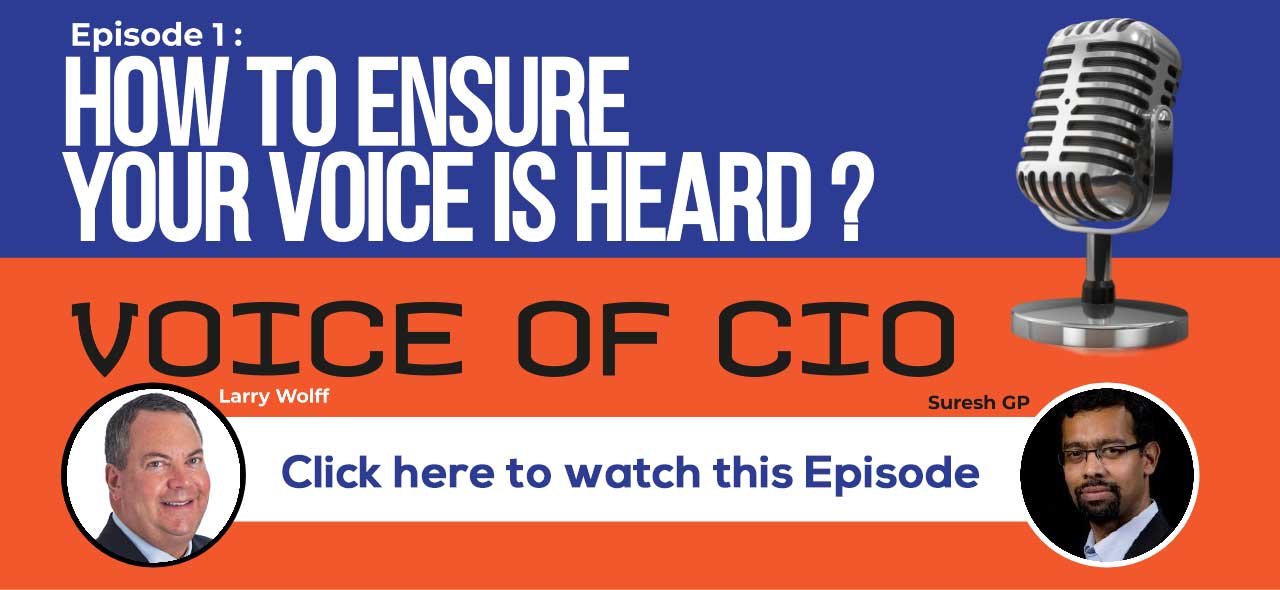Voice of CIO – Episode 1 | How to ensure your voice is heard, with Larry Wolff
In the first edition of the YouTube series, Voice of CIO, titled, ‘How to ensure your voice is heard’, Suresh GP, MD, TaUB Solutions interviews Larry Wolff, founder and CEO of Wolff Strategy Partners, a boutique consulting firm specializing in ‘Enterprise Strategy Management’ and ‘Digital Transformation’.
Larry, for three decades now, is known to possess a huge experience of having served at several top positions as CEO, CIO, CTO, and Management Consultant for many public, private, and international emerging growth companies.
The conversation opens with Larry being asked to expand on
What is meant by a term he is often found alluding to, called ‘IT value journey’.
Larry states,that the ‘IT value journey’ is something that every organization goes through and there are three elements in it,
- A) maintenance of stuff, i.e, maintaining the systems and the infrastructure,
- B) to enhance: trying to keep up with the business needs and
- C) eventually earning the privilege to transform the business.
Having done numerous IT turnarounds and having gone through this process in mid-market companies in as little as 18 months, the IT value journey is really an evolutionary process for every IT firm. He says some companies stay in that maintained state for years together, whereas the real idea is that as we bring about an improvement and get better at the things that we do, we earn the trust, credibility and respect from the business, which in turn enables us to deliver greater business value, i.e., in other words going ahead with the maintenance, enhancement and transformation process.
As an extension on this point, Suresh further questioned Larry as to
How a CIO goes about measuring the value of IT, demonstrating it to the business executives.
Larry replies with exuberance, saying he found it shocking when he learnt over the years that most IT Companies do not measure the value they deliver. Citing an example of a huge global company he worked for around 9/11 times, when revenue disappeared and sales opportunities were just vanishing, he reveals how he along with his team had proved that IT was the only one that was putting money on the bottom line. It was made possible as they had been measuring IT all along to the point that the CFO was certifying the tens of millions of dollars a year that it was contributing to the bottomline. Larry also gives a brief summary hereabout the four categories this measurement can be done in, with underlining remarkable valuable tips and takeaways such as:
- Eighty percent of the businesses are under the illusion that the help-desk is IT because that’s who they interact with a lot of IT organizations talk about uptime. But who cares, I don’t care if your servers are up; I care if the service that I am using is available when I’m doing that big sales presentation. So measuring availability of core systems is also key and what we advise people is take your worst performing metric – maybe there’s an old homegrown system that’s down a lot, but a lot of other things are up you know, almost 100% of the time. Take your worst performing system, make that your baseline and then continuously improve it.
- Another important thing to measure: a lot of people are using agile methodology now; most are struggling with their agile transformation, but in the agile methodology the significant thing is ‘how do we get good at measuring velocity and how do we get to the point where we can do one or two more story points per sprint’.
- The most important measure in software development is where I am finding bugs. If I am finding bugs in unit testing that’s a blessing, but finding bugs after we’ve gone to production turns out to be super expensive and so we want to be measuring these again and again, with continuous improvement being the final thing.”
Providing a quick overview of what IT strategy management, Larry then informs us about the book, ‘The Balanced Scorecard’, written by Doctors Kaplan and Norton, back in the late nineteen nineties. Implementing the balanced scorecard methodology produced amazing results, and in the process of strategic planning he says they realized that strategy without execution is just a desire and the gap between strategy and execution needs to be bridged. This has led to the creation of an eight step process which he said they have been using for ages, which has been shared in this video through a graphic presentation. This eight step process ensures execution on planned strategy.
Since Larry Wolf is known to be a big fan of continually improving the IT journey, he was asked,
How does he build this constant improvement as a culture, as along with being a CIO, he is yet only a part of an organization, and everyone else too is an integral part of thinking and acting.
Larry was delighted that Suresh brought up this hugely important factor, elaborates eagerly on it, highlighting the fact that to bring about a cultural build up, of the quite a few things that have to happen, first of all the CIO has to live, breathe and believe IT and it’s got to pour out of your veins.
Finally, on the rise of non technical CIOS, Larry informs us that they have actually started writing a series on this, with a couple of articles already written in it; and which may turn out to be another handbook very soon. He himself is throughout this activity, having thousands of followers and personally is coming up with his articles every week.
The very helpful and interesting conversation ends with Larry appreciating and thanking Suresh for having started this wonderful series, ‘Voice of CIO’, after having very generously shared his own real world experience and practical nuggets of wisdom.
Do not miss the video to have the full pleasure of this conversation.






